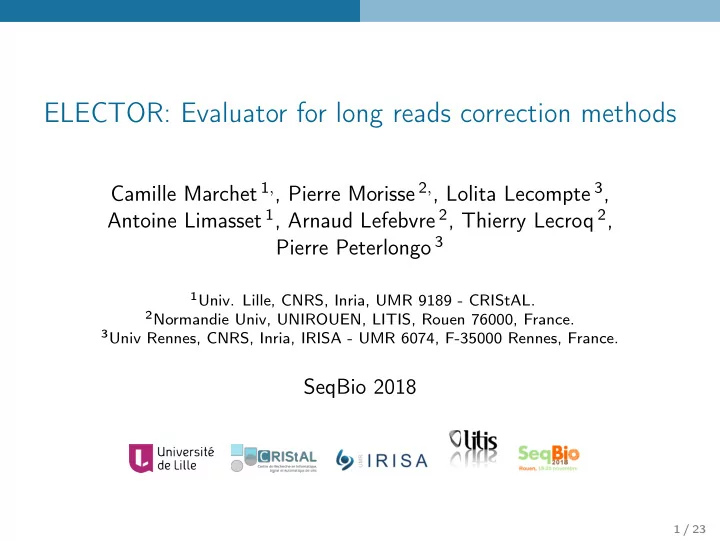

ELECTOR: Evaluator for long reads correction methods Camille Marchet 1 , , Pierre Morisse 2 , , Lolita Lecompte 3 , Antoine Limasset 1 , Arnaud Lefebvre 2 , Thierry Lecroq 2 , Pierre Peterlongo 3 1 Univ. Lille, CNRS, Inria, UMR 9189 - CRIStAL. 2 Normandie Univ, UNIROUEN, LITIS, Rouen 76000, France. 3 Univ Rennes, CNRS, Inria, IRISA - UMR 6074, F-35000 Rennes, France. SeqBio 2018 1 / 23
Introduction: errors in long reads Context Long reads : fast evolving field but error rates remain high Need quality for assembly, variant calling, . . . From [Rang et al. 2018] 2 / 23
Introduction: correction assessment Ever-increasing list of correction methods: 2012: 3 2016: 4 2013: 1 2017: 7 2014: 3 2018: 3 2015: 2 “Which tool better performs on my problem ?” A lost bioinformatician “My corrector works on this ATTAGATTAC toy example so it should do the job.” Pierre M., anonymous overly confident developer “Let’s do something !” C3G MASTODONS long read correction group 3 / 23
Introduction: correction assessment SOTA Only one tool (LRCstats [La et al. 2017]) Rather slow Number of metrics displayed could be increased Correction quality assessment objectives Handle most of the correctors Quick (time ≃ correction step’s time) Scalable Reproducible Easy to include in benchmarks Information for users and developers 4 / 23
Introduction : long reads correction methods Hybrid Mapping short reads/assembled short reads on long reads Map LR on paths of graph of short reads Self Produce consensus from LR by multiple mapping on a template LR Map LR on paths of graph of LR Produce consensus from LR using graphs built from the reads’ k -mers Corrected reads Can be missing Can be trimmed (shorter than the original) Can be split (separated in several corrected fragments) Can be elongated (longer on left or right end by bringing some context of the graph) 5 / 23
Main idea: compare different versions of a read Multiple sequence alignment of triplets advantages: access recall/precision difficulty: scaling solution: MSA segmentation 6 / 23
ELECTOR: Overview 7 / 23
Main contributions of ELECTOR w.r.t. LRCstats ELECTOR LRCstats error rate ✔ ✔ recall ✔ ✖ precision ✔ ✖ deletions ✔ ✔ insertions ✔ ✔ substitutions ✔ ✔ split reads ✔ ✔ mean missing size ✔ ✖ %GC before/after correction ✔ ✖ ratio correction in homopolymers ✔ ✖ remapping stats ✔ ✖ assembly stats ✔ ✖ + decreased running time 8 / 23
Segmented multiple sequence alignment MSA segmentation Same idea as Pierre’s talk (LoRSCo) For triplet of sequences Alignment method: POA [Lee et al. 2002] Added feature: handle large gaps 9 / 23
Issue with large gaps Segmentation MSA rules Mainly for efficiency: 1 If a corrected read is extremely short: do not align, report 2 If the set of seeds is very small (corrected and reference are very dissimilar): do not align, report In both cases we cannot segment and would have to perform the regular MSA: too long Issue with trimmed/split reads 10 / 23
Handling large gaps 11 / 23
Validation of MSA segmentation Simulated datasets from E. coli "1k" experiment: 1k mean length, 10% error rate, coverage of 100X "10k" experiment: 10k mean length, 15% error rate, coverage of 100X Corrected with MECAT Experiment Recall Precision Correct bases Time "1k" MSA 93 .96 % 93 .48 % 97.6 4 % 11h "1k" segmentation + MSA 93 .81 % 93 .51 % 97.6 3 % 38min "10k" MSA 84.5 1 % 88 .35 % 95.2 9 % 107h "10k" segmentation + MSA 84.5 9 % 88 .28 % 95.2 5 % 42min Orders of magnitude speed-up Similar metrics values 12 / 23
Metrics computation: indels 13 / 23
Metrics computation: split/trimmed/extended 14 / 23
Metrics computation: recall/precision 15 / 23
Metrics computation: recall/precision in modified reads 16 / 23
Validation of MSA for computing metrics Simulation for ground truth Data: 1X and 10X E. coli Errors: 15% and 20% errors Simulated correction Compare ELECTOR results and ground truth for 10X: metric ELECTOR difference (% ground truth) recall(%) 98.99 4.0 E-2 precision(%) 99.92 1.0 E-1 error rate 9.920E-2 2.3 indels/mismatches in uncorrected 8380984 4.1 indels/mismatches in corrected 491728 3.4 17 / 23
Results : data sets / correctors Dataset A. baylyi E. coli S. cerevisiae Reference organism Genome size 3.6 Mbp 4.6 Mbp 12.2 Mbp Simulated Pacific Biosciences data Number of reads 8,765 11,306 30,132 Average length 8,202 8,226 8,204 Number of bases 72 Mbp 93 Mbp 247 Mbp Coverage 20x 20x 20x Illumina data Source ERR788913 Genoscope Genoscope Coverage 50x 50x 50x List of correctors CoLoRMap, HALC, HG-CoLoR, Jabba, LoRDEC, Nanocorr, NaS, Canu, Daccord and LoRMA 18 / 23
Results: running time Method CoLoRMap Nanocorr Daccord Jabba A. baylyi Corrector 57min 2h52min 20min 2min LRCstats 3h59min 3h44min 3h58min 4h02min ELECTOR 1h07min 11min 5min 1h19min E. Coli Corrector 1h25min 3h17min 27min 2min LRCstats 4h57min 3h56min 4h20min 5h12min ELECTOR 1h21min 14min 15min 32min S. cerevisiae Corrector - - - 5min LRCstats - - - 12h01min ELECTOR - - - 2h15min High speed-up in comparison to LRCstats 19 / 23
Results: comparison to LRCstats Nanocorr daccord ELECTOR LRCstats ELECTOR LRCstats Error rate 0.339 0.3983 0.422 0.4498 0.98503 - 0.98836 - Recall Precision 0.99424 - 0.98468 - Deletions 46,596 56,708 58,110 72,547 Insertions 237,798 279,970 306,930 336,686 Substitutions 143,605 45,783 72,265 25,643 Trimmed / split reads 1,612 - 123 - Mean missing size 341 - 3,026 - Time 14min 3h52 15min 3h50 20 / 23
Results: comparison to LRCstats 21 / 23
Conclusion & Perspectives Conclusion Fast assessing of a corrector’s results Many metrics: recall/precision/indels/trimmed/split reads/assembly/remapping. . . A limitation: a reference genome is required Innovative developments in segmentation for fast MSA computing Perspectives Results on larger genomes & real data to come Support RNA-seq ( https://gitlab.com/leoisl/LR_EC_analyser ) Assess variant calling Availability: https://github.com/kamimrcht/ELECTOR 22 / 23
Acknowledgements SeqBio committees GenScale team BONSAI team TIBS Team C3G MASTODONS 23 / 23
Homopolymer detection 23 / 23
Recommend
More recommend